News
BU President Dr. Melissa Gilliam Shares Her Story at ASM
On the morning of Tuesday, November 12, BU President Dr. Melissa Gilliam addressed the BUA community at our weekly all-school meeting. In her remarks, President Gilliam shared details of her early life: the daughter of a groundbreaking abstract painter and the first Black woman reporter at the Washington Post, Gilliam attended independent schools in Washington, DC, and spoke fondly of a high-school English teacher who, in a comment on one of her papers, encouraged Gilliam to be a "Renaissance person." Gilliam took her teacher's advice to heart: her indirect career path to university leadership reflects an abiding curiosity and a refusal to be pigeonholed into just one field of study -- much like BUA students.
Before her installation as BU's 11th president, and also its first female and first Black president, in September of 2024, President Gilliam served as provost and executive vice president at The Ohio State University, and, previously, as vice provost of the University of Chicago. She is also a professor of obstetrics and gynecology and of pediatrics, with a focus on adolescent medicine and wellbeing. Gilliam studied English literature at Yale and received her Master of Arts in philosophy and politics from Oxford.
During the Q&A portion of our all-school meeting, President Gilliam graciously answered student questions on taking a circuitous career path despite the pressures of early specialization; the role of student voice in her BU administration; and how she carves out space for herself as a Black woman in predominantly white spaces.
This week's ASM talk is our second visit from President Gilliam this fall. In September, she took a student-led tour of BUA and met with students to hear about their high school experiences. At an internal BU meeting this fall, President Gilliam referred to BUA as a "Jewel of Boston University." We are grateful to President Gilliam for taking the time to listen and learn about our school, and for her recognition of BUA as an exceptional place with much to offer the broader BU community.
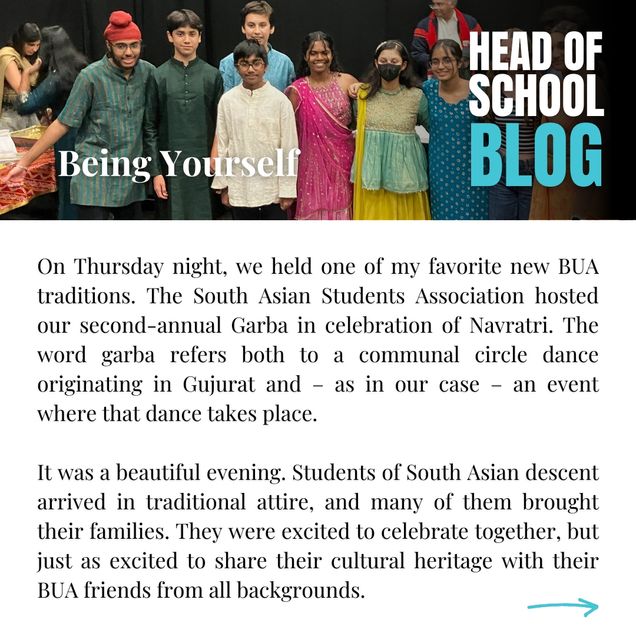
Being Yourself
On Thursday night, we held one of my favorite new BUA traditions. The South Asian Students Association hosted our second-annual Garba in celebration of Navratri. The word garba refers both to a communal circle dance originating in Gujurat and – as in our case – an event where that dance takes place.
It was a beautiful evening. Students of South Asian descent arrived in traditional attire, and many of them brought their families. They were excited to celebrate together, but just as excited to share their cultural heritage with their BUA friends from all backgrounds. They taught their peers several variations of the dances. In no time at all, several dozen students, parents, and teachers were up on their feet dancing, smiling, and learning from each other. I was struck and grateful to be part of a community where the South Asian students feel so comfortable bringing this important part of their lives to school. I was equally grateful to see so many students and adults with no previous experience in this style of dance get up and give it a try. They all seemed free to be themselves. The garba captured so much of what is special about this community. Looking forward to next year!
BUA Sophomore Earns Silver Medal at World Tap Championships
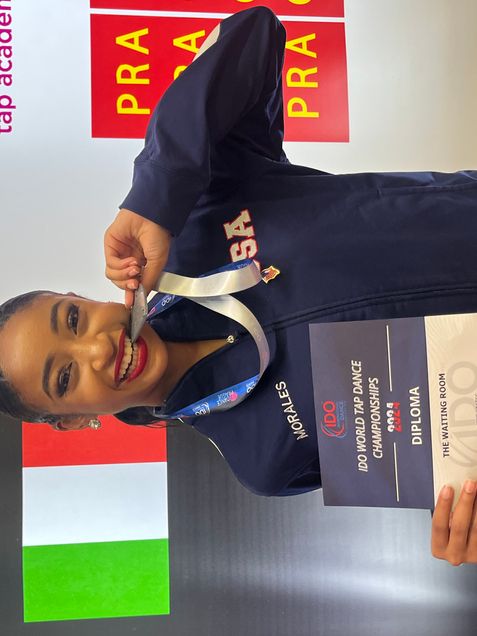 BUA sophomore Lyahnnette Morales '27 and her USA teammates brought home the silver medal at the IDO World Tap Championships held in Prague, Czech Republic earlier this month. Despite being just 15 years old, Lyahnnette competed in the Adult Tap Formation category, which is usually reserved for those ages 17-31. She shares the below reflections on the experience and on her dance career:
BUA sophomore Lyahnnette Morales '27 and her USA teammates brought home the silver medal at the IDO World Tap Championships held in Prague, Czech Republic earlier this month. Despite being just 15 years old, Lyahnnette competed in the Adult Tap Formation category, which is usually reserved for those ages 17-31. She shares the below reflections on the experience and on her dance career:
Congratulations on your accomplishments at the IDO World Tap Championships! Tell us about that experience.
The World Tap Championships was a great experience for me. This is my second time competing at IDO's Tap Championship -- I went when I was 10 years old and came home with 5th place. This year World's was held in Prague, Czech Republic at the University of New York in Prague's (UNYP) arena.
There were five days of competition in different age categories, starting Wednesday morning and ending Sunday night. After spending some time sightseeing, I came to the arena every day to support USA's team. I competed on Friday with my dance "The Waiting Room" in the Adult Formation's first round. Adult Formation is a category of dancers aged 17-31 (I was moved up although I am only 15), who are judged heavily on intricate transitions and formations while tap dancing. This takes a lot of precision and focus on where you are exactly at all times. In the first round, the judges score the formations heavily on their cleanliness and precision throughout the transitions of the dance.
After performing our dance we waited for the results, which determined whether we made it into the semi-final round. As we waited, other categories performed their dances and we watched the Parade of Nations, an event in which teams from each country shows off their gear and accessories. Once all countries have shown off their national spirit, the judges are re-introduced and catwalk down the red carpet. It's a very entertaining and loud event as every nation competes to be the loudest and show the most spirit.
After this, the results were announced. "The Waiting Room" moved on to the semi-finals, allowing us to perform the dance again the next day, now competing to be one of the top six teams moved into the finals round. In the semi-final round, judges focus the scoring more on tapping and facial expressions.
The next morning, we got on shuttles to the UNYP arena. We did a dry rehearsal, meaning no tap shoes or costumes, just running through and cleaning up the piece. We ran through the dance countless times, making sure not only our tapping was perfect, but our traffic patterns, formations and arm movements are as well. Between our morning rehearsal and semi-final performance, I watched some of the other dances and traded pin and other trinkets with the other nations. Trading is a big part of the IDO World Tap Championships. You can trade anything from pins to caps to backpacks -- the only rule is they have to be on theme with your nation (USA flag pins, America hats, etc.). By the end of the week, I ended up with trinkets from Australia, United Kingdom, Canada, Switzerland, Germany, Mexico, and Czechia.
That evening, we performed in the semi-final round. Our group collectively agreed that even if we don't make it through to the finals, that this was our best run of the dance and we're proud of the job we did. But the judges must have also thought it went well because we moved on to finals! We all hugged and put our USA team tracksuits on over our costumes. Standing off to the side of the stage with American flags wrapped around us, we wait as the suspenseful trumpet fanfare plays. After the announcer reveals 6th-4th place, we excitedly huddle together, not believing we made it to the podium. When the announcer reveals who gets the bronze medal, the majority of the team is already in tears. After a pause, the announcer calls "The Waiting Room" from team USA. By this time we're all in hysterics as we squeeze to take our place on the podium, get our second place trophy, and receive silver medals shaped like the metal on a tap shoe. After a hard week of dancing we get to go back to the hotel and celebrate our win for USA. Competing at the IDO World Tap Championships will forever hold a special place in my heart as an experience where I got to make new friends from all over and push my limits.
How long have you been dancing?
I've been dancing for thirteen years. I started at the age of two.
What’s your favorite style of dance, and why?
I enjoy many styles of dance, but if I had to choose one I would say Jazz is my favorite. I grew up being one of those little girls who is very sassy, so Jazz gives me an outlet to portray that side of my personality without coming off as bratty or spoiled. Not only that, but Jazz has so many minor styles inside of it and each one is its own art. I personally love all types of Jazz since I can portray different characters inside of it, but some of the micro styles include Musical Theatre Jazz, Classic Jazz, Heels Jazz and Jazz Funk.
What role does dance play in your life?
Dance has always had a very prominent role in my life. I believe it teaches discipline, motivation, and good work ethic. Dancing isn't just an art, I see it as a sport. It's the type of activity where you train year-round like athletes and then have to compete onstage and make everything look effortless and artistic. Dance gives me a way to express myself without having to use words, just movement, and to really explore my own body's limitations and capabilities.
What’s the most exciting place or experience your dance career has brought you?
The most exciting place dance has brought me to would be to the Rolex Grand Prix in London, England in 2019.
How do you balance your schoolwork with a demanding dance schedule?
I dance five days a week after school so balancing my schoolwork with other schedules is a difficult task. I find doing schoolwork on the way to dance very helpful. By the time I get home it's usually 10:00 p.m. and I feel too exhausted or drained to do homework as effectively. I also believe fueling my body and napping is good between school and dance. I try my best to rest because fatigue can lead to possible injuries in dance or subpar work in school. Taking 5-10 minute non-electronic breaks between each task or homework assignment works the best for me to efficiently get schoolwork done. Although my sleep schedule isn't always consistently the greatest, around 11:30 p.m.-12:00 a.m. if I'm still doing homework I decide it's time to go to sleep and I can finish the rest of my tasks in the morning.
What advice would you share with other current or prospective BUAers who hope to pursue an outside commitment at a high level?
Some advice I would share would be to always do things with the spirit of excellence. Meaning never be mediocre in a task because it's something you committed to and if you do it to the best of your ability it could open doors to opportunities you never knew could be possible. Continuing to work hard is always the best method you can have ,and I stand by this because "Hard work beats talent when talent doesn't work hard." - Tim Notke.
Cross Country Recap 10/22
Lucy '25 shares a recap of the BUA Cross Country team's race on October 22:
The cross country team ran another amazing race this week on the familiar territory of Gann Academy. The team pushed through unexpected heat and extended hills and ended strong! It was a great race for spectators with three loops around Gann’s soccer field, a short stint in the woods and winding around the back of the school. The race ended in a final sprint around the edge of the baseball diamond, perfect for fans to watch. Special shoutout to Sara '28 for crushing her first ever race! Another shoutout to our seniors, running their final (ever!) regular season race. And finally, congratulations to all the team members who joined this year, pushed themselves in practice, and have been running incredible races. Their hard work is obvious to anyone who watches and it’s incredible to see how much the team has grown. We’ll carry our momentum into next week, when we run our championship race at the Cambridge School of Weston! Go Terriers!
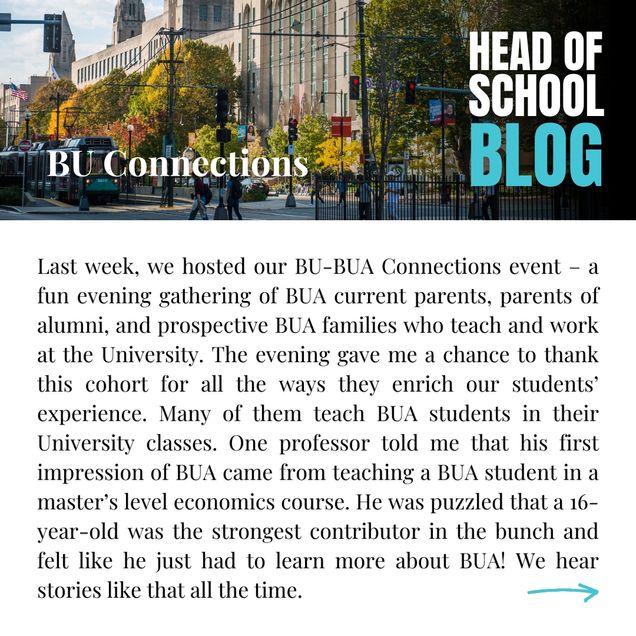
BU Connections
Earlier this week, we hosted our BU-BUA Connections event – a fun evening gathering of BUA current parents, parents of alumni, and prospective BUA families who teach and work at the University. The evening gave me a chance to thank this cohort for all the ways they enrich our students’ experience. Many of them teach BUA students in their University classes. One professor told me that his first impression of BUA came from teaching a BUA student in a master’s level economics course. He was puzzled that a 16-year-old was the strongest contributor in the bunch and felt like he just had to learn more about BUA! We hear stories like that all the time.
These families help out in so many other ways. They hire BUA students as researchers in their labs. They advise senior theses. They speak at our school meetings and suggest other great colleagues to do the same. They open the doors for our kids to engage with departments and interdisciplinary institutes up and down Commonwealth Avenue – like the Software & Application Innovation Lab and EPIC (BU’s 15,000 square-foot makerspace), both of which are now part of our 10th-grade seminar program. And they spread the word about BUA with colleagues across the University. We are a much stronger school for their partnership.
Boys & Girls Soccer Recap 10/18
Metch '25 shares the following recap of the BUA Boys Soccer team victory against Commonwealth at Fall Festival on October 18:
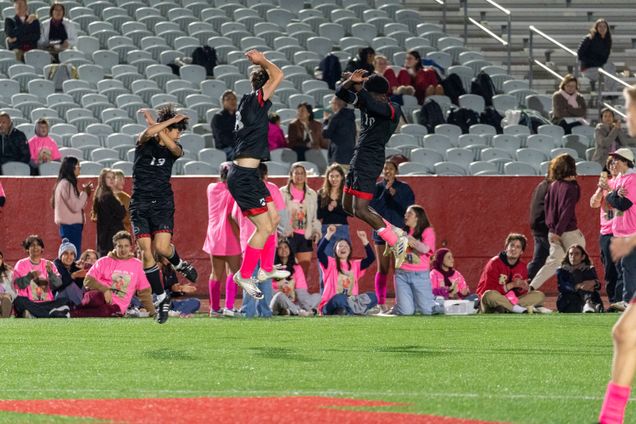 Boston University Academy took the lead early, with Ollie '25 opening up the scoreboard by tapping in a corner kick to make it 1-0 in the first half. Commonwealth fought fiercely, locking down BUA's offense until the second half. Then, Austin '28 dazzled by weaving through five defenders down the right, delivering a perfect assist to Connor '25 at the far post, who tapped it in beautifully. Caleb '27 followed with a stunning far-post strike from a tough angle, extending the lead to 3-0 with just ten minutes left.
Boston University Academy took the lead early, with Ollie '25 opening up the scoreboard by tapping in a corner kick to make it 1-0 in the first half. Commonwealth fought fiercely, locking down BUA's offense until the second half. Then, Austin '28 dazzled by weaving through five defenders down the right, delivering a perfect assist to Connor '25 at the far post, who tapped it in beautifully. Caleb '27 followed with a stunning far-post strike from a tough angle, extending the lead to 3-0 with just ten minutes left.In the final moments, Commonwealth launched a relentless attack, pinning BUA in their half. But with 30 seconds remaining, Nathan '28 made a crucial defensive stop, passing to Connor '25, who one-touched it to Caleb '27. Caleb then curved a perfect pass to Metch '25, who sealed the match with an incredible team-driven goal, ending the game 4-0 in style.
Alex '25 and Rose '25 penned the below recap of the Girls Soccer team's Fall Festival win, also on October 18:
 The night was young. The vibes were high. Last Friday, BUA battled Commonwealth on our home turf for our annual Fall Fest. Senior Night left the girls with a strong sense of team spirit and bittersweet determination, as we honored senior players, Lani '25, Sahithi '25, Corinna' 25, Eesha '25, Rose '25, and Alex '25. The girls fought hard to get ahead in the first half, initially finding little luck. The team’s goalie, Maggie '27, held the fort down with stupendous saves as the girls shook off their nerves and “locked in,” as the kids would say. In a wave of freshman greatness, Skye '28 sent a beautifully placed cross to meet Sarah '28 in the box, who saw her chance and took it, scoring to win the game! BUA held off Commonwealth with a newfound energy, pressing on offense and closing down on defense. What truly made the game special was not only the girls’ excitement to play, but the BUA’s excitement to watch. The crowd’s cheers, posters, and smiles dominated the field, creating a perfectly joyful environment for victory. Thanks BUA and roll Terriers!
The night was young. The vibes were high. Last Friday, BUA battled Commonwealth on our home turf for our annual Fall Fest. Senior Night left the girls with a strong sense of team spirit and bittersweet determination, as we honored senior players, Lani '25, Sahithi '25, Corinna' 25, Eesha '25, Rose '25, and Alex '25. The girls fought hard to get ahead in the first half, initially finding little luck. The team’s goalie, Maggie '27, held the fort down with stupendous saves as the girls shook off their nerves and “locked in,” as the kids would say. In a wave of freshman greatness, Skye '28 sent a beautifully placed cross to meet Sarah '28 in the box, who saw her chance and took it, scoring to win the game! BUA held off Commonwealth with a newfound energy, pressing on offense and closing down on defense. What truly made the game special was not only the girls’ excitement to play, but the BUA’s excitement to watch. The crowd’s cheers, posters, and smiles dominated the field, creating a perfectly joyful environment for victory. Thanks BUA and roll Terriers!
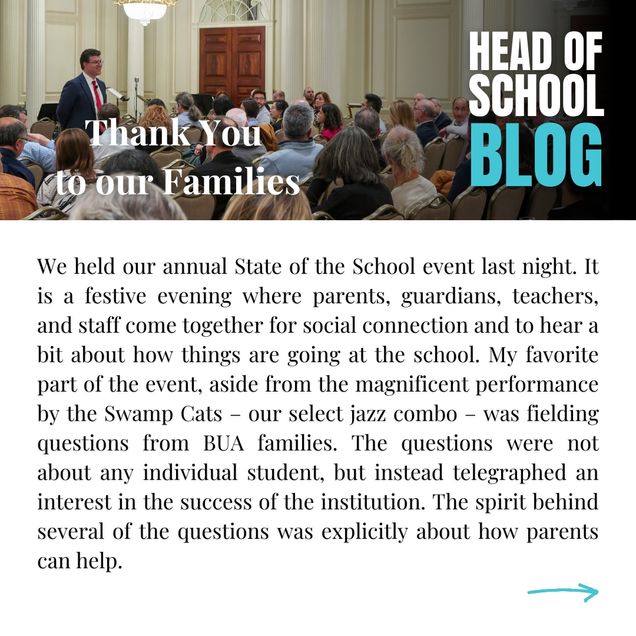
Thank You to our Families
We held our annual State of the School event last night. It is a festive evening where parents, guardians, teachers, and staff come together for social connection and to hear a bit about how things are going at the school. My favorite part of the event, aside from the magnificent performance by the Swamp Cats – our select jazz combo – was fielding questions from BUA families. The questions were not about any individual student, but instead telegraphed an interest in the success of the institution. The spirit behind several of the questions was explicitly about how parents can help. What kind of social entrepreneurship opportunities are available to students and how can parents open more doors? As the school builds more partnerships in the City of Boston, what role can parents who live in Boston play?
This school is fortunate to have such dedicated and generous families. Each year, dozens of parents and guardians volunteer across multiple areas of school life: admissions, parent network gatherings, teacher appreciation, the advisory board, chaperoning school events, and more. 86% of families last year made the school a philanthropic priority and made a gift to the school’s Annual Fund – in addition to their investment in tuition. Those funds underwrite all of our faculty-staff professional development efforts, bolster our financial aid program, and enhance our academic, athletic, and extracurricular offerings. In the coming weeks, we will roll out a new way for parents and guardians to help: informational interviews, shadow days, and career panels for recent BUA graduates just getting started on their professional journeys. To all of you who keep finding ways to give back, thank you.
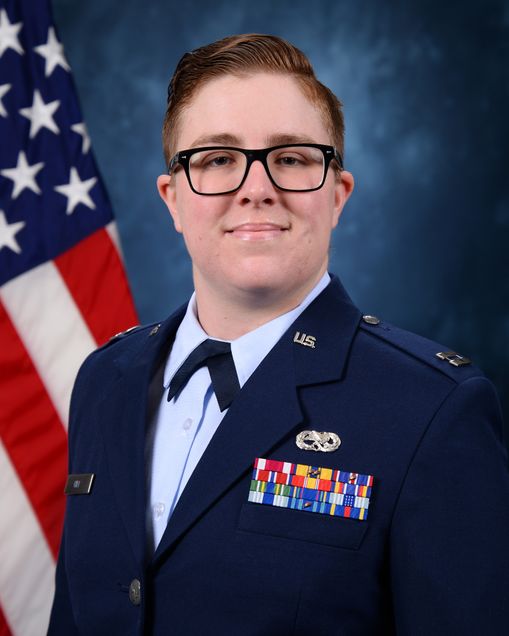
Major Lydia Hill ’11 Receives Distinguished Alumni Award
 BUA is delighted to present the 2024-2025 Distinguished Alumni Award to Major Lydia Hill '11 for her service in the United States Air Force as well as for her advocacy on behalf of LGBTQIA airmen.
BUA is delighted to present the 2024-2025 Distinguished Alumni Award to Major Lydia Hill '11 for her service in the United States Air Force as well as for her advocacy on behalf of LGBTQIA airmen.
This annual award, launched in 2022, goes to an alumnus/a who best exemplifies the values of BUA and has used those qualities to make an impact on the community and world around them. Nominations for the award are solicited from the entire alumni community, and recipients are selected by the BUA Alumni Council.
Major Hill graduated from BUA in 2011 and went on to the United States Air Force Academy, where she received her commission in 2015 as a distinguished graduate. Major Hill left her own legacy at USAFA, founding the Spectrum Alliance for LGBTQIA cadets, which is still in operation today. Major Hill has worked with KC-135s and F-16s as an Aircraft Maintenance Officer, served as a Wing Executive Officer, has deployed in support of named operations worldwide, and been stationed in England, South Korea, Illinois, and San Diego. She holds two master’s degrees: an MA in Psychology from San Diego State and an MA in Professional Counseling from Lindenwood University. Major Hill currently serves as an Instructor in the Department of Behavioral Sciences and Leadership at the Air Force Academy in Colorado Springs, Colorado.
Major Hill has maintained her connection to BUA. In 2021, she returned to address the community at a Veterans Day all-school meeting. In her remarks, Major Hill spoke openly about mental health issues, LGBTQIA inclusion, and leading a life of service. She reflected on BUA as being “the first place I really saw people step up and be agents of change,” and shared her gratitude for a BUA teacher who inspired her “by living his life openly and with courage.” Major Hill’s candid reflections received an enthusiastic reception from the BUA audience, with students expressing their deep appreciation in the Q&A following her talk.
We are grateful to Major Hill for her service and for her commitment to BUA, and look forward to welcoming Lydia back to campus this year to celebrate her many accomplishments.
Keep your eyes peeled for the Fall 2024 edition of Odyssey, the magazine of Boston University Academy, which includes an in-depth Q&A with Lydia on her BUA experience, her career, and what winning the Distinguished Alumni Award means to her.
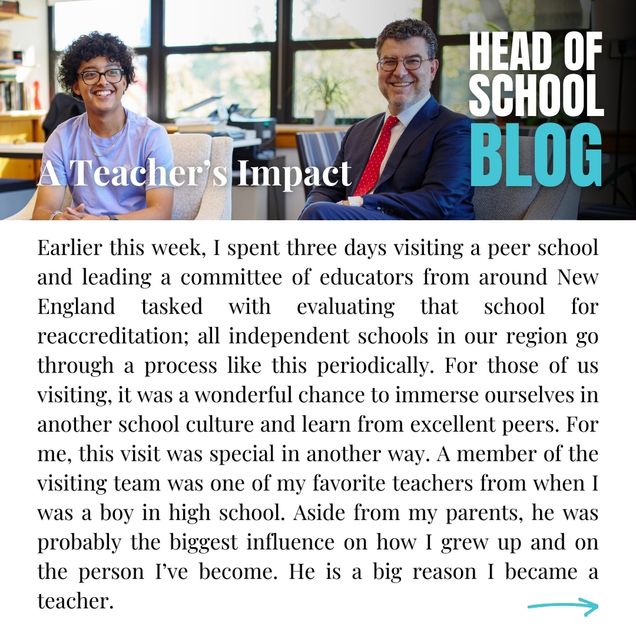
A Teacher’s Impact
Earlier this week, I spent three days visiting a peer school and leading a committee of educators from around New England tasked with evaluating that school for reaccreditation; all independent schools in our region go through a process like this periodically. For those of us visiting, it was a wonderful chance to immerse ourselves in another school culture and learn from excellent peers. For me, this visit was special in another way. A member of the visiting team was one of my favorite teachers from when I was a boy in high school. Aside from my parents, he was probably the biggest influence on how I grew up and on the person I’ve become. He is a big reason I became a teacher. We have stayed in touch over the years, which has mostly consisted of me asking for advice. I have just recently made the transition to calling him by his first name! Our relationship is different now, but I still find so much comfort in his support, friendship, and love.
Last weekend, we hosted an event for BUA alumni from the 1990s – the first generation of the school’s life. In the early stages of our planning, we wondered how we would convince the graduates to come back. Our answer: bring back their teachers. Giants in the life of the school walked the halls again – teachers from the early years like Mark Davies, John Talbot, Megan Staples, Sandra Michelman, Catherine Pollock, and Rich Horn, people who helped shape the curriculum and culture we now steward. In one touching moment, an alumna gave a copy of her recently-published book of poetry to one of those teachers as a recognition of the role he played at the start of her literary journey. She is now a professor of literature, passing it on to the next generation.
The historian Henry Adams once wrote that “A teacher affects eternity; he can never tell where his influence stops.” Perhaps it never does. These moments made me even more grateful for the dedicated and talented teachers I work with every day here and who will be lifelong mentors for this generation of BUA students.
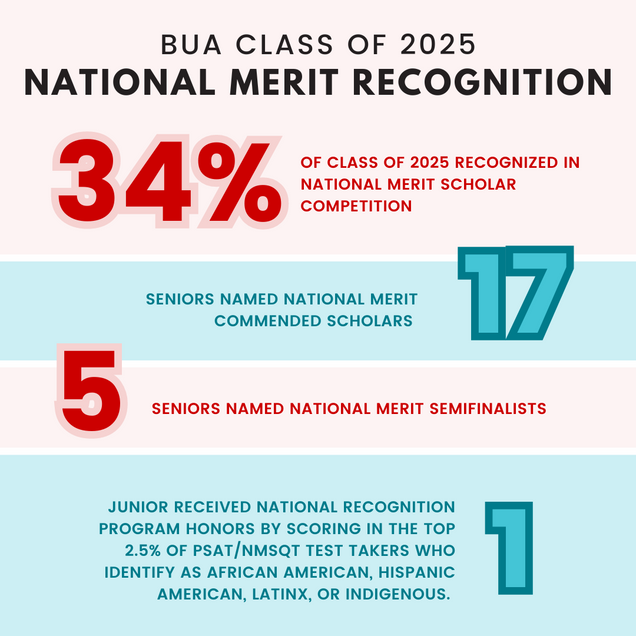
BUA Seniors Earn National Merit Honors

Thirty-four percent of the Boston University Academy Class of 2025 received recognition in the 70th annual National Merit Scholarship Program competition. The competition honors the nation’s scholastic champions and recognizes exceptional academic promise in high school seniors nationwide.
Seventeen current BUA seniors were named National Merit Commended Scholars. Out of these 17 Commended Scholars, five BUA seniors were named National Merit Semifinalists, placing them among the top 1% of all US high school seniors who entered the competition.
Over 1.3 million juniors in about 21,000 high schools entered the 2025 National Merit Scholarship Program by taking the 2023 Preliminary SAT/National Merit Scholarship Qualifying Test (PSAT/NMSQT). The nationwide pool of Semifinalists includes the highest-scoring entrants in each state.
Semifinalists will have the opportunity to compete for one of 2,500 National Merit $25,000 Scholarships. National Merit Scholar finalists will be announced in February of 2025.
One member of the BUA Class of 2025 received College Board National Recognition Program honors by scoring in the top 2.5% of PSAT/NMSQT test takers who identify as African American, Hispanic American, Latinx, or Indigenous.
Congratulations to all of BUA’s honorees on this well-deserved recognition!